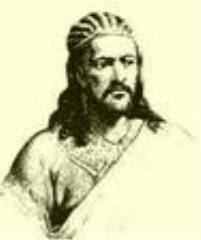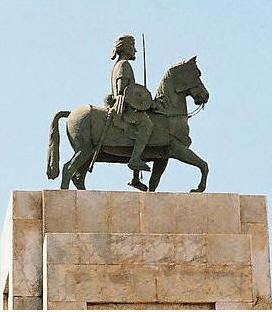Name Ahmad Ibrahim Issue Mohammad ibn Ahmad | House Walashma dynasty | |
 | ||
Reign c. 1527 – February 21, 1543 Died February 21, 1543, Amhara Region, Ethiopia Similar People Estevao da Gama, Piri Reis, Seydi Ali Reis, Diogo Lopes de Sequeira | ||
Ahmad ibn ibrahim al ghazi
Ahmad ibn Ibrahim al-Ghazi (Somali: Axmad Ibraahim al-Gaasi, Harari: አሕመድ ኢቢን ኢብራሂም አል ጋዚ, "Acmad Ibni Ibrahim Al-Gaazi" [Afar], Arabic: أحمد بن إبراهيم الغازي ) "the Conqueror" (c. 1506 – February 21, 1543) was an Imam and General of the Adal Sultanate who rebelled against Abyssinia and defeated several Abyssinian emperors. With the help of an army mainly composed of Somalis, Harla (Hararis), Afars, Arabs and Ottoman Turks, Imam Ahmad (nicknamed Gurey in Somali, "Gura" in Afar and Gragn in Amharic (ግራኝ Graññ), all meaning "the left-handed"), embarked on a conquest which brought three-quarters of Abyssinia (modern day Ethiopia) under the power of the Muslim Sultanate of Adal during the Abyssinian-Adal War from 1529-43.
Contents

Ahmad ibn ibrahim al ghazi
Ethnicity

Imam Ahmad is regarded by many scholars as an ethnic Somali. However, other historians have disputed his ethnicity, with Ahmad sometimes interpreted as being a Harari Many Somali clans played a strong role in Gurey's conquest of Abyssinia, however these clans went to war not so much as Somalis but as Muslims."
Early years

Imam Ahmad was born in 1506 just 30 miles away from Harar. Ahmad spent most of his childhood in the city of Harar. Due to the unislamic rule during the reign of Sultan Abu Bakr ibn Muhammad, Ahmad would leave Harar for Hubat. He married Bati del Wambara, the daughter of Mahfuz, the Governor of Zeila. In 1531, Bati would give birth to their first child named Muhammad.

When Mahfuz was killed returning from a campaign against the Abyssinian emperor Lebna Dengel in 1517, the Adal sultanate lapsed into anarchy for several years, until Imam Ahmad killed the last of the contenders for power and took control of Harar.

Ethiopian historians such as Azazh T'ino and Bahrey have written that during the period of his rise to power, Ahmad ibn Ibrahim al-Ghazi had converted many Oromo pastoral people to Islam.
In retaliation for an attack on Adal the previous year by the Abyssinian general Degalhan, Imam Ahmad invaded Abyssinia in 1529, supplementing his force with considerable numbers of muskets purchased from the Ottomans, which would panic the Abyssinian troops. Imam Ahmad maintained the discipline of most of his men, defeating Emperor Lebna Dengel at Shimbra Kure that March.
Conquest of Abyssinia
The chronicle of Imam Ahmad's invasion of Abyssinia is depicted in various Somali, Abyssinian and other foreign sources. Imam Ahmad campaigned in Abyssinia in 1531, breaking Emperor Lebna Dengel's ability to resist in the Battle of Amba Sel on October 28. The Muslim army of Imam Ahmad then marched northward to loot the island monastery of Lake Hayq and the stone churches of Lalibela. When the Imam entered the province of Tigray, he defeated an Abyssinian army that confronted him there. On reaching Axum, he destroyed the Church of Our Lady Mary of Zion, in which the Abyssinian emperors had for centuries been crowned.
The Abyssinians were forced to ask for help from the Portuguese, who landed at the port of Massawa on February 10, 1541, during the reign of the emperor Gelawdewos. The force was led by Cristóvão da Gama and included 400 musketeers as well as a number of artisans and other non-combatants. Da Gama and Imam Ahmad met on April 1, 1542 at Jarte, which Trimingham has identified with Anasa, between Amba Alagi and Lake Ashenge. Here the Portuguese had their first glimpse of Ahmad, as recorded by Castanhoso:
While his camp was being pitched, the king of Zeila [Imam Ahmad] ascended a hill with several horse and some foot to examine us: he halted on the top with three hundred horse and three large banners, two white with red moons, and one red with a white moon, which always accompanied him, and [by] which he was recognized.On April 4, after the two unfamiliar armies had exchanged messages and stared at each other for a few days, da Gama formed his troops into an infantry square and marched against the Imam's lines, repelling successive waves of Muslim attacks with musket and cannon. This battle ended when Imam Ahmad was wounded in the leg by a chance shot; seeing his banners signal retreat, the Portuguese and their Abyssinian allies fell upon the disorganized Muslims, who suffered losses but managed to reform next to the river on the distant side.
Over the next several days, Imam Ahmad's forces were reinforced by arrivals of fresh troops. Understanding the need to act swiftly, da Gama on April 16 again formed a square which he led against Imam Ahmad's camp. Although the Muslims fought with more determination than two weeks earlier—their horse almost broke the Portuguese square—an opportune explosion of some gunpowder traumatized the horses on the Imam's side, and his army fled in disorder. Castanhoso laments that "the victory would have been complete this day had we only one hundred horses to finish it: for the King was carried on men's shoulders in a bed, accompanied by horsemen, and they fled in no order."
Reinforced by the arrival of the Bahr negus Yeshaq, da Gama marched southward after Imam Ahmad's force, coming within sight of him ten days later. However, the onset of the rainy season prevented da Gama from engaging Ahmad a third time. On the advice of Queen Sabla Wengel, da Gama made winter camp at Wofla near Lake Ashenge, still within sight of his opponent, while the Imam made his winter camp on Mount Zobil.
Knowing that victory lay in the number of firearms an army had, the Imam sent to his fellow Muslims for help. According to Abbé João Bermudes, Imam Ahmad received 2000 musketeers from Arabia, and artillery and 900 picked men from the Ottomans to assist him. Meanwhile, due to casualties and other duties, da Gama's force was reduced to 300 musketeers. After the rains ended, Imam Ahmad attacked the Portuguese camp and through weight of numbers killed all but 140 of da Gama's troops. Da Gama himself, badly wounded, was captured with ten of his men and, after refusing an offer to spare his life if he would convert to Islam, was executed.
The survivors and Emperor Gelawdewos were afterward able to join forces and, drawing on the Portuguese supplies of muskets, attacked Ahmad on February 21, 1543 in the Battle of Wayna Daga, where their vastly outnumbered troops of 9,000 managed to defeat the 15,000 soldiers under Gragn. Gragn was killed by a Portuguese musketeer, who was mortally wounded in avenging da Gama's death.
His wife Bati del Wambara managed to escape the battlefield with a remnant of the Turkish soldiers, and they made their way back to Harar, where she rallied his followers. Intent on avenging her husband's death, she married his nephew Nur ibn Mujahid on condition that Nur would avenge Imam Ahmad's defeat. In 1554-55, Nur departed on a Jihad, or Holy War, in the eastern Abyssinian lowlands of Bale, and Hadiya. In 1559, he invaded Fatagar, where he fought against the Abyssinian emperor Galawdewos, and killed him in battle.
Legacy
"In Ethiopia the damage which Ahmad Gragn did has never been forgotten," wrote Paul B. Henze. "Every Christian highlander still hears tales of Gragn in his childhood. Haile Selassie referred to him in his memoirs, "I have often had villagers in northern Ethiopia point out sites of towns, forts, churches and monasteries destroyed by Gragn as if these catastrophes had occurred only yesterday." To most Somalis Ahmad is a national hero who fought against Abyssinian aggression on their ancient territories.
